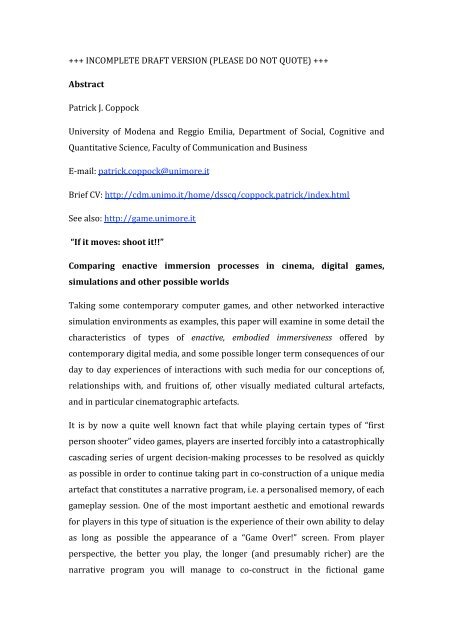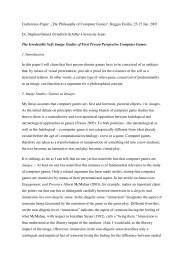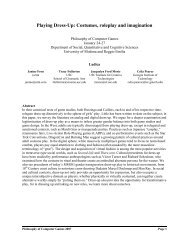+++ INCOMPLETE DRAFT VERSION (PLEASE DO NOT QUOTE) ++ ...
+++ INCOMPLETE DRAFT VERSION (PLEASE DO NOT QUOTE) ++ ...
+++ INCOMPLETE DRAFT VERSION (PLEASE DO NOT QUOTE) ++ ...
Create successful ePaper yourself
Turn your PDF publications into a flip-book with our unique Google optimized e-Paper software.
<strong><strong>++</strong>+</strong><strong>INCOMPLETE</strong><strong>DRAFT</strong><strong>VERSION</strong>(<strong>PLEASE</strong><strong>DO</strong><strong>NOT</strong><strong>QUOTE</strong>)<strong><strong>++</strong>+</strong>AbstractPatrickJ.CoppockUniversity of Modena and Reggio Emilia, Department of Social, Cognitive andQuantitativeScience,FacultyofCommunicationandBusinessE‐mail:patrick.coppock@unimore.itBriefCV:http://cdm.unimo.it/home/dsscq/coppock.patrick/index.htmlSeealso:http://game.unimore.it“Ifitmoves:shootit!!”Comparing enactive immersion processes in cinema, digital games,simulationsandotherpossibleworldsTaking some contemporary computer games, and other networked interactivesimulationenvironmentsasexamples,thispaperwillexamineinsomedetailthecharacteristics of types of enactive, embodied immersiveness offered bycontemporarydigitalmedia,andsomepossiblelongertermconsequencesofourdaytodayexperiencesofinteractionswithsuchmediaforourconceptionsof,relationships with, and fruitions of, other visually mediated cultural artefacts,andinparticularcinematographicartefacts.It is by now a quite well known fact that while playing certain types of “firstpersonshooter”videogames,playersareinsertedforciblyintoacatastrophicallycascadingseriesofurgentdecision‐makingprocessestoberesolvedasquicklyaspossibleinordertocontinuetakingpartinco‐constructionofauniquemediaartefactthatconstitutesanarrativeprogram,i.e.apersonalisedmemory,ofeachgameplaysession.Oneofthemostimportantaestheticandemotionalrewardsforplayersinthistypeofsituationistheexperienceoftheirownabilitytodelayas long as possible the appearance of a “Game Over!” screen. From playerperspective, the better you play, the longer (and presumably richer) are thenarrative program you will manage to co‐construct in the fictional game
environment through skillful use of the tools and strategies offered by thegameplayenginethatcreatesandmaintainstheinteractivefictionalworld.Other, ever more sophisticated online multiplayer simulation and gameenvironments offer opportunities for player initiative and co‐constructionactivities, not only by way of finding personalised interpretational narrativepathways through the fictional environment, but also through redesigning,complementingandreformingitinvariousways.Thisalters,sometimesinquiteradicalways,thegeneralandmorespecificcontextsinwhichdifferentkindsofplayer‐gameplayandplayer‐playerinteractionoccur.This is clearly be a very different kind of media experience from that ofconsumersoftraditionalcinematicfiction,althoughcinema‐goers(asisthecase,as Iser, Eco and others have pointed out, also for consumers of “paper‐based”literature) certainly play an active co‐constructive role in interpreting, andattributing sense to, the narrative program of a film as it unfolds before theireyes.Inthecaseofcinematicfictionalnarratives,however,suchinterpretationprocesses largely take place without any significant degree of whole body, orevenbodypart,movementonthepartofviewers,andtodayitisofconsiderableinteresttospeculateabout,anddiscuss,justwhatthisquitespecificdifferenceintermsofwhatweshallrefertohereasembodiedimmersionprocessesmayhavetosayinexperientialandculturalvaluetermsforconsumersofoneortheothertypeofmediaartefact,andinthelongerterm,forthedifferentculturalcontextsand(notleast)marketplacestheseartefactsatpresent‘populate’.
<strong><strong>++</strong>+</strong><strong>INCOMPLETE</strong><strong>DRAFT</strong><strong>VERSION</strong>(<strong>PLEASE</strong><strong>DO</strong><strong>NOT</strong><strong>QUOTE</strong>)<strong><strong>++</strong>+</strong>Level1:DefiningthefieldofplayI’dliketostartthistalkbyaskingyouwhetheryoubelieveFirstPersonShootervideogames could be said to constitute a particular kind of literary orcinematographicgenre?For those of you who may not know exactly what a First Person Shooter(hereafter FPS) game is, here is a screenshot from one quite well‐knownexample,anactionvideogamecalled“HalfLife” 1 (Fig.1).Figure1:ScreenShotfrom“HalfLife”Tokeepthingssimplefornow,I’lljustpointoutthatthephrase‘FirstPerson’refersheretothefactthatinthistypeofgameplayersareintendedtoenvisionthemselvessituatedbehindapowerfulautomaticrifle(orsomeotherweaponortool) that they operate by way of a proxy character or avatar in the gamepossibleworld.Theavatarisenvisionedascarrying,loadingorfiringtheweaponasavirtualprosthesisoftheplayerduringthegame.Thissymbolicprojectionof
embodied first person player actions onto the moving images on the screen,opens up a hybrid zone of mediation that blends what goes on the actualexperiential world of the player with what goes on the fictional world of thegame.This augmented reality effect is amplified by the fact that FPS players do notnormally‘see’theirownavatarsinasimulatedembodiedforminfrontofthemonthescreenastheyplay,onlythebarreloftheweapon.However,someFPS’sdisplayashortvideonarrativeatthebeginningtosetthesceneforthegameandintroduce players to the characters they will meet there, including their ownavatar.Inthissense,FPS’salsohavequitealotincommonwithonlineMassivelyMultiplayerRole‐PlayingGames(MMRPG’s)wherelargenumbersofplayerstakepart at the same time battling with one another as avatars. In these games,however,playerswillgenerallybeviewingandcontrollingavatarsin“fullbody”form, seen from a “Second Person” (proximate other) perspective. (Fig 2 –ResidentEvil)Figure2:ScreenShotfrom“ResidentEvil”Avatars in both FPS’s and RPG’s are usually identitifed by a unique charactername and a personal biography that sometimes appears in the opening video
narrative or other information materials that come with the game. Here, too,theremaybeimagesofprincipalcharacters.InHalfLifethehero,whomplayersare to identify with while playing, is “Dr. Gordon Freeman”, a theoreticalphysicist(Fig3).Figure3:Dr.GordonFreemanfrom“HalfLife”In FPS games like Half Life, players, or rather, their avatars find themselvessuddenly inserted into catastrophically cascading streams of critical decisionmakingprocessesthatneedtoberesolvedasquicklyandeffectivelyaspossiblein order for the avatar to ‘survive’. As they struggle to manage the continualcrisesthrownatthembythegame‐enginethatcreatesandmanagesthefictionalenvironment with its objects and events, the player and the game‐engine intandem co‐construct a unique narrative program that characterises thegameplaysessioninquestion.MassimoMaietti 2 hasreferredtosuchgameplayartefacts as terminal texts. In reality, most terminal texts remain merelyephemeral,sincetheyonly‘exist’asaflowofembodiedphenomenalexperienceasplayersareactuallyplayingthegame.
Sometimes, however, players opt to record their gameplay sessions with amachinimafunctionbuiltintothegameengine.Thiscreatesastepbystepvisualrecordofwhoisplaying,thestateofplay,wheretheiravatarsareinthegame,and what they are doing there, and so on. The result of this cinematographicmicroproduction activity is a small animated movie that may be archived as aseparatefile.Thiscreatesanenduringformofpersonaltestimony,adigitalisednarrative memory of gameplay sessions that can be viewed again and again,shared and discussed with others on YouTube, Facebook or other prosumerorientedinstrumentsavailableontheweb.Onnumerousgameforumswefindlively exchanges and discussions of these terminal narratives, which are oftenreferredtoas‘speedruns’.(Figure4)Figure4:Framefrom“HalfLife”SpeedRunThese serve as a kind of shop window or public platform where players candemonstrate their skills for others, and perhaps reveal how they manage tosubvertgamerulesinpassingquicklyfromonegameleveltoanother,gatheringasmanycredits,andlosingasfew‘lives’astheycanintheprocess.
In FPS games, one of the most significant aesthetic and emotional rewards forplayers seems to be a satisfying sense of empowerment deriving from theirexperienceofavoiding–oratleastpostponing–unplannedappearancesofthe“GameOver!”screenmostgamesendwith.ExpertFPSplayershavedevelopedaveryhighdegreeofcontroloverdemandingdecision‐makingprocessesinawelldefinedactioncontextrequiringextremelyfastreactiontimesandfinelytunedeye‐hand coordination. From player perspective, the better one becomes atplaying the game, the more experientially rich, both in one’s own and in peerjudgement quality terms, are the narrative programs one manages to coconstructinthecourseofanygivengamesession.Butthereisalsomoreherethanmeetstheeye.Theintentionalactofelectingtoaimatspeedrunsratherthanjustplayingthegameasitissupposedtobeplayedaccordingtotherules,mayalsohaveanimportantsecondarysymbolicfunctionfor players and their peers. It can be the first step on the way to a moresystematictestingofthelimitsnotonlyofthegamequagame,butalsothegameenginequagamepossibleworldgenerator,orbuilder.Thisrepresentsakindofmetadiscursivedistancinginrelationtoaplayer’searlier,moreimmediate,andperhapslessanalytical,formsofimmersioninthefictionalworldofthegame–anattempttotryandunderstandbetter“howitallworks”.Fromthere,playersmay then move on to teach themselves how to modify game objects or othermorecomplexaspectsofthefictionalworld,suchasgamelevels,orevenwholegames, giving rise to a whole new level of autonomous programming activityreferredtoingamingcirclesas“modding” 3 .Thisinitsturnmayalsobeanotherfirst step on the way to becoming an independent game designer, producer orevenresearcher,perhapsbywayofaseriesoffreelanceengagementsasobjectorlevelprogrammersforlargerestablishedgameindustryfirmsorconsortia.SinceIhaveworkedquitealotinthepastonprocess‐orientedwritinginrelationto text based virtual worlds, and have recently also begun to focus more andmoreoninnovationprocessesderivingfromexperiencesofcooperitionactivitiesin prosumer oriented online social networking environments like YouTube,Facebook, or simulated online worlds that offer property acquisition anddevelopmentpossibilitieslikeThere,SecondLifeorTwinity,Ifinddigitalgames
as a meta‐genre especially interesting in this respect, since they seem toillustratereallyquitewellhowtheergodiccharacteroftheparticular‘handson’enactive experience offered by such games, engages players right from thebeginning in actually doing something practical and constructive in a digitalenvironment that may also at the same time be potentially innovative, eitheraloneorincooperationwithothers.So,viewedfromwithinanenactiveexperiential‐relationalparadigm,gamesnotonlychallengeandtrainplayerstoengageinquitedifferentformsofembodiedergodic action in relation to play objects than are required of readers orcinephiles,theymayalsoopenupforamyriadofotheractionpossibilitiessuchasbecomingagame(re‐)writer,designer,producerorresearcherasImentionedbefore…This view of player interactions with game possible worlds as forms ofpotentiallycreativeintentionalactionhasquitealotincommonwithUmbertoEco’sdescriptionsoftheinterplaybetweenintentioauctorisandintentiolectorisin open aesthetic texts, and his model writer and model reader dichotomy, buthere there is an added corporeal dimension, including possible forms of socialandculturalmobilityandtransmedia,transworldcareerdevelopment.However,aswecansee,sofarnoobviousanswertomyinitialquestionaboutwhether or not FPS games might constitute something like a literary orcinematographicgenrehasemerged.Thisisnotparticularlystrange,sincetherewill clearly be many different ways of understanding the notion ‘literary’,‘cinematographic’and‘genre’,nowandinthefuture.Butwecancertainlyclaimthat FPS games are a kind of aesthetic interactive art form that offers playerscertain kinds of enactive experiences of fictional possible worlds. Indeed, thissortofgeneraldescriptionmaywellbetheonethatbestofalllinksgamesperséto more traditional genres of literature and cinema. But there is also anotherissueatplayherethathascausedquitealotoflivelydiscussioningamestudiesand game philosophy circles over the years, and this has to do with whethercomputer games are most profitably conceived of as primarily narrative orprimarilyludicincharacter.
Clearly,allinstancesofactualgame‐playareinsomesensebuiltupintermsofageneralnarrativeschema:theyhaveprotagonists,interactionsandrelationshipsbetweenthese;thereisabeginning,amiddleandanend;andchangesofstatetakeplacealongtheway,asisthecaseinliteraryandcinematographicworks.Indeed,speedruns,oranyotherterminaltextrecordedduringgame‐playcanbedescribedinpreciselythesetermsasakindof“shortstory”or“film”.But games also offer players spaces for ludic interactions: a ‘magic circle’(Huizinga, Salen & Zimmerman) that privileges certain types of play activitiesover others. All games have explicit or implicit, formal or informal, rules thatguide players in how they should play there, as do board games, sports fields,schoolyards,theme‐parksandotherpublicplayspaces.Anotherapproachtodefininggamegenres(EgenfeldtNielsen,HeideSmithandPajares Tosca 2008) suggests a framework based on the success criteria ofgames.Whatdoesittaketoactuallysucceedinplayingthegame?Theirsystemissplitintofourprinciplegenres:actiongames(requiringfastreflexes),adventuregames (requiring abilities in logic), strategy games (requiring analysis ofindependent variables) and processoriented games (requiring the desire toexploreandmasternewthings).EspenAarseth,apioneerincontemporarygamestudies,delineatedthenotionofgenre by combining theories of information, communication, literature andrhetoric.Hissuggestionwastotreatgenreasacomplexsystemconsistingofalarge number of independent variables, and to rate games according to whichclustersofthesevariablestheymostprominentlydisplay.InabookonCybertextin the early 90’s, he coined the term “ergodic literature” in an attempt tocharacteriseandclassifyanumberofearlyhypertextandother“virtualreality”projects.Subsequently,hehasgoneontoapplythissamenotiontointeractivemediaingeneral,andcomputergamesinparticular.Indoingso,heisseekingtodirect our attention to the fact that hypertexts, virtual reality environments,computergames,oranyotherkindofinteractivedigitalartmediaform,alwaysrequire quite specific, often distinctive, forms of emotional, physical and
cognitiveworkbytheirreaders/users/playerstosuccessfullyread,useorplaythem.Thisergodicaspectofinteractionswithgamemediarefers,then,tospecifictypesof work players carry out as they operate actual world cybernetic feedbackdevicestointeractwith,andwork(orfight)theirwaythrough,fictionaldigitalpossibleworlds.Intheearlydaysofcomputergaming,ofcourse,mostworkofthis kind was carried out with a computer keyboard, a mouse, or a simplejoystickdevice.Sincethen,thingshavehottedupconsiderably.Gameconsolesnowhavededicatedhandsetsthatenableevenmorerapidcontrolmovements.3DgameconsolesliketheNintendoWiihavewands,foot‐bodyfeedbackplatesandotherkindsofmovementsensors(Figure5)thatmonitorplayers’physicalmovements so they can have their game world avatars mirror their ownmovements in real time in the game possible world on a screen before them(Figures6&7)Figure5
Figure6Figure7Touch screens have been around for quite some time now, and are rapidlybecomingsmallerandsmallerandevermoresensitive,andthoughasyetnotsowidelyusedasgameinterfaces,wemightwellexpectthemtobesointhenotsodistant future. “Immersive” V‐R helmets and goggles came into vogue for a
period a while back, but have since gone a bit out of fashion. They might wellreturn at some stage in the future. More recently, too, there have even beendemonstrationsofbiofeedbackdevicesthattapplayers’brainwavepatternsandallow them to manipulate colours and objects in virtual play spaces byconcentratingattentionon,or“thinkingabout”them(Figure8).Figure8:ScreenShotfromapromotionalwebsiteforanexperimentalBrainWaveUserInterfaceSystemBut if we return to the more general issue of defining and describing gamegenres, we can see that in the specific case of FPS games, their semanticdescriptoralsomakesreferencetothequitespecificpositioningofthein‐gameplayer‐weapon avatar in relation to ‘its’ player who is normally positionedimmediatelyinfrontofthegameconsolescreen.Duringplay,theweapon‐avatarappears‘glued’toafixedmedianpositionattheverybottomofthescreen,andnever really moves from there (though it does sometimes disappear when notneeded). The rest of the in‐game possible world is then in movement towardsthe avatar and ‘around’ it, which is what creates an impression of a forwardmovement of the player‐avatar hybrid through the game world during play.
WhenusingFPSgameconsolesplayersintheirturnareoften‘glued’toafairlycircumscribed position in the holistic actual world gamespace immediately infrontofthescreen,leavingthemlittlepossibilityoffreemovementiftheyaretosucceedindealingwiththestressfuldemandsofthegame(Figure9)Figure9:ResidentEvilPlayer(BolognaCineteca:VideogameArchive)In this context the console screen acts as a transitional visual interface thatfacilitatestheentanglementofwhatisgoingoninthepossibleworldofthegamewith the embodied enactive experience of the player in the actual world. Thisblending of actuality and possibility in lived experience is of course also whathappens during fruition of literary or cinematographic works. The differenceshere are fundamentally ergodic, since enactive engagement in different worktypesisnecessaryifplayers,readersandcinemagoersaretomakethemostoftheir enactive experiences of each specific media type and their respectivematerialplatforms.Seen from an enactive experiential perspective – with a focus on players’embodiedexperiencesofimmersioninaholisiticludicenvironment–gameplay
isarichentanglementexperienceinvolvingthegameconsole,thepossibleworldgamespaceitgeneratesandmediates,andtheplayer,includingrelevantaspectsofhisorherongoingexperienceofeverydayhereandnowactuality,orreality(Figures10,11&12).Figure10:Childrenplayingacomputergametogetherinfrontofthescreen
Figure12:AcoupleengagedplayingagameusinghandheldcontrolconsolesFigure13Cinemagoerswatchingafilmwhleeatingpopcorn
Elsewhere (Coppock 2008) I have argued that we cannot really considercomputer games as anything else but real in ontological. experiential andpragmatic terms. It is, after all, an empirical fact that players take gamesthemselves as material‐immaterial hybrid cultural artefacts, and the gameplaypossible worlds they allow them to ‘immerse’ themselves in, so seriously thatthey are willing to devote significant amounts of time, energy and money inacquiring them, setting them up and playing with them, and also in discussingthem,andtheirexperiencesofthem,withfamilyandfriends.Inthisparticularrespect, computer games represent exactly the same inherent reality, actualityand “socialness” 4 as any other hybrid cultural artefact offering experiences ofinteraction with fictional possible worlds, such as literature and cinema. Theworld market for computer games is already huge 5 , and steadily growing. In2008 sales of computer and video game industry hardware, software andperipheralstotaled$22billion, withentertainmentsoftwaresales countingforjustoverhalfthatfigure–a22.9%increaseinrelationto2007–accordingtotheEntertainmentSoftwareAssociation(ESA)Sowhatdowemeanwhenwespeakoftheenactivecharacterofourembodiedexperience of actual and possible worlds? Well, to paraphrase philsopher AlvaNoë’s characterisation of this: our subjective experience of the world, he says,isn’t merely determined by neural states set up by recurrent patterns ofenvironmental stimulation alone; the qualitative character of our perceptualexperience depends on our mastery and exercise of painstakingly learnedsensorimotorskills.Ourexperienceandunderstandingsoftheworldhavetodowiththefactthatweareconstantlylearninghowtorelatetoanddothingswith,forus,sometimes“alien”formsofothernesssaswemovearoundinitandenterintoludicorotherkindofentanglementsandengagementswithit.Intalkingaboutliterary,cinematographicorludicexperienceinenactionterms,then, we are essentially bringing into focus the empirical factuality of ourcomplex existence as physical beings with highly developed, diversified, agilebodies that allow us to actively move through, interact intentionally with andexperience one another, and all kinds of aesthetic and other objects that wecreateandexchangeinveryrichkindsofways.
Looking is one thing, touching another, walking around another, picking upanother, opening up another, taking to pieces and putting back together indifferent ways another, and so on. Indeed, all forms of cultural innovationpreciselydependoncomplexenactiveprocesseslikethisgoingonallthetimeandentanglingsynergeticallywithoneanother.Enactive interfaces facilitate multiple forms of interaction, experimentation orotherformsofcooperitionwithotherness,inwhateverguise,whereveritmaybeintheworld,orelsewhere.Thismaybeseenasapotentiallyusefuldevelopmentfor us and our societies, since it respects the fact that as human beings wecontinuallyneedtoremodelandremakeoursenseofselfandourownabilitiesandpossibilitiesthroughlive,embodiedentanglementintheprocessualflowofbeing and meaning that is constituted by our own and others’ actions in theimmediate or at‐a‐distance presence of many, many other animate andinanimate objects and beings, in other spaces and places, wherever these mayhapppentobesituatedintheworld.Inthisconnectiontoo,openorsemi‐opensocialnetworkingenvironmentswithaludicprofilesuchasFacebook,MySpaceandYouTubeseemtocaptureatleastsome of the essence of this particular way of understanding of our essentialhumanity.Therearealready,andwillcertainlycometobe,many,manymore–andifweare interested and make some eforts to do so, we will certainly be able todiscoverthesetoo…References(provisionallist)Espen Aarseth, 1997, Cybertext: Perspectives on Ergodic Literature, JohnsHopkinsUniversityPress,Ian Bogost, Nick Montfort, 2009, Racing the Beam. The Atari Video ComputerSystem,Cambridge(MA),London:MITPress.
Ian Bogost 2007, Persuasive Games. The Expressive Power of Videogames,Cambridge(MA),London:MITPress.Dario Compagno, & Patrick J. Coppock (Eds.), (in press) "Computer Games,Between Text and Practice", Thematic Special Number ofE/C: Rivistadell’AssociazioneItalianadiStudiSemiotici.Patrick J. Coppock (in press) "Are Computer Games Real? Process, Interactionand Meaning in Past, Present and Future Possible Worlds". Under review forpublication in Springer Press Anthology The Philosophy of Computer Games,(Eds.)JohnRichardSageng,HallvardFossheim,TarjeiMandtLarsen.PatrickJ.Coppock,(inpress)"Here,ThereandEverywhere:GlocalisingIdentityinTransworldTransmediaGenuisLoci".UnderreviewforpublicationinSpecialIssueofMedieKultur:JournalofMediaandCultureResearch‐"Onlineworldsasmediaandcommunicationformat",GuestEditorKjetilSandvikUmbertoEcoTheRoleoftheReader,Pat Harrigan & Noah Wardrip-Fruin (Eds.), 2004, First Person. New Media as Story,Performance and Game, Cambridge (MA), London, MIT Press.Pat Harrigan & Noah Wardrip-Fruin (Eds.), 2007, Second Person. Role Playing andStory in Games and Playable Media, Cambridge (MA), London, MIT Press.JesperJuul2005,HalfReal.VideoGamesBetweenRealRulesandFictionalWorlds,Cambridge (MA), London: MIT Press.Thomas Egenfeldt Nielsen, Jonas Heide Smith and Susana Pajares Tosca, 2008,UnderstandingVideoGames.TheEssentialIntroduction,NewYork:RoutledgeAlvaNoë 2004, Action in Perception, Cambridge (MA), London: MIT Press.1 http://en.wikipedia.org/wiki/Half‐Life_(video_game)
2 SemioticadeiVideogiochi,2004,Unicopli3 http://en.wikipedia.org/wiki/Mod_(computer_gaming)4 Intheintroductiontohiseditedvolume“TheSocialnessofThings.Essaysonthe Socio‐Semiotics of Objects”, Stephen Harold Riggins (1994: 1‐6) uses theneologism‘socialness’to“callattentiontotheintegrationofobjectsinthesocialfabric of everyday life.”. He continues: “It is not only with people and animalsthat we interact but also with objects. Objects are a cause, a medium and aconsequence,ofsocialrelationships.Trulytheonlycontextinwhichartifactscanbeobservedisintheirrelationtohumans.Wepracticallyalwaysperceiveotherpeopleinsituationsinwhichtheyinteractwithobjectsandaresurroundedbythem.Evenduringourmostsociallyisolatedexperiencesweareneveraloneinthatsense.”5 “Overallcomputerandvideogameindustryhardware,softwareandperipheralsales climbed to $22 billion in 2008, with entertainment software salescomprising $11.7 billion of that total figure – a 22.9% jump over the previousyear – the Entertainment Software Association (ESA) announced today. Theindustrysetthenewrecord,calculatedbymarket‐researchfirmNPDGroup,onthestrengthofaDecembersalesmonthinwhichindustryrevenue($5.3billion)topped $5 billion for the first time in any single month. By comparison, asrecently as 1997, the industry generated $5.1 billion over the entire year.” PRNewswire(accessedFebruary17th2009):http://news.prnewswire.com/ViewContent.aspx?ACCT=109&STORY=/www/story/01‐28‐2009/0004962345&EDATE=






